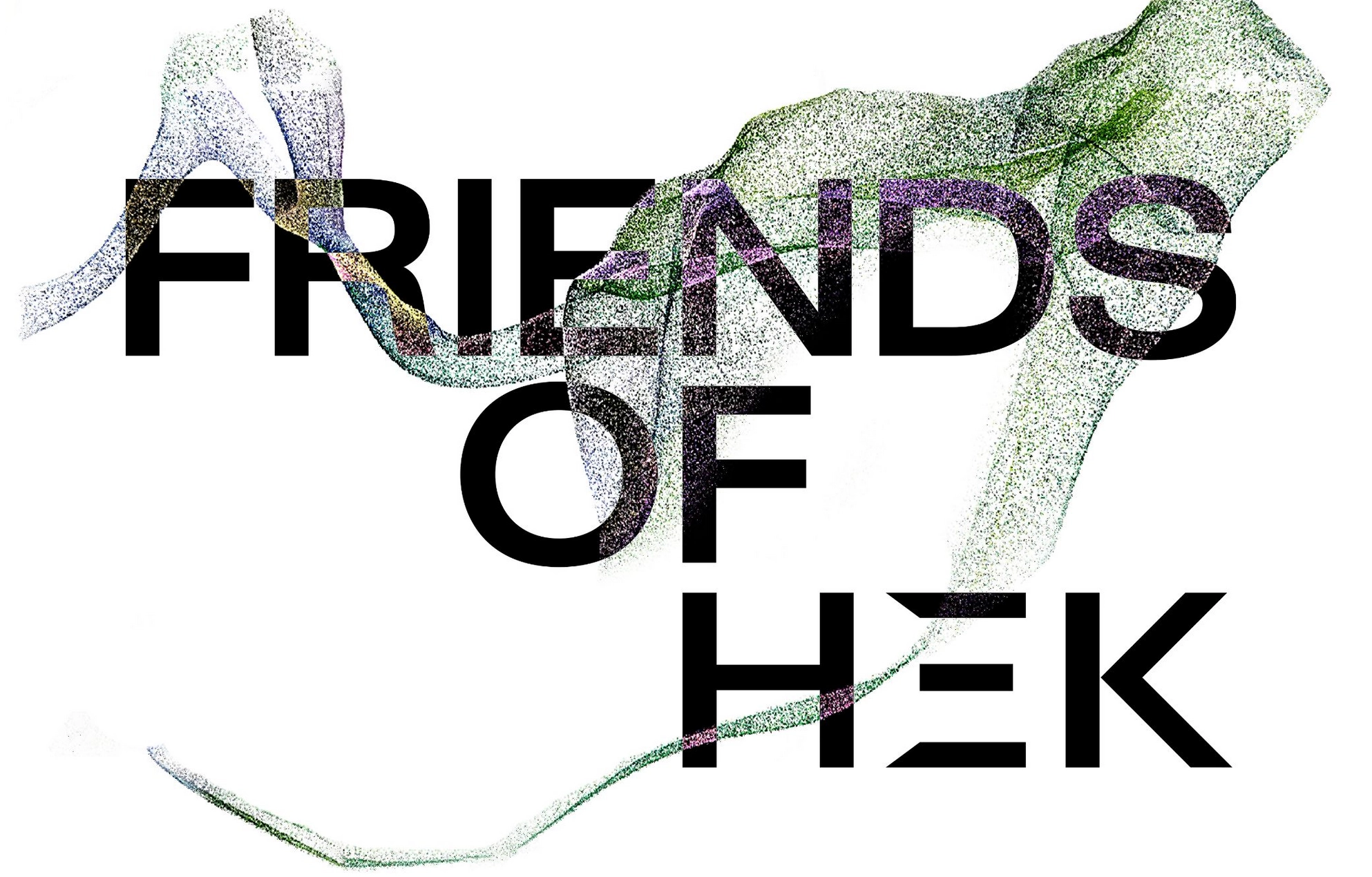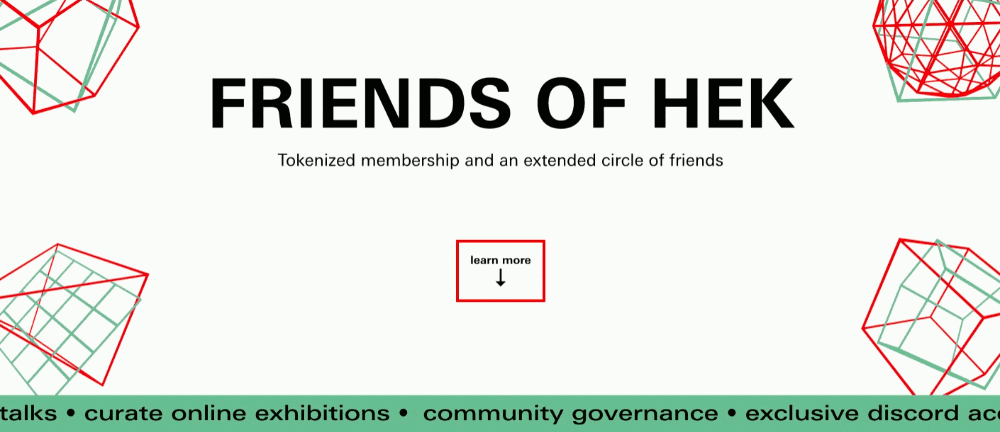
Helping Basel’s HEK build digital community with the world’s first tokenized museum membership
Switzerland’s HEK (House of Electronic Arts) has been the leading museum for digital art, media, and culture since 2011. As a center of creative technology, HEK aims to be at the forefront of what’s relevant, willingly pushing into areas that are unknown and undefined — areas that include blockchain and Web3.
Turning standard museum membership into an experiment in digital community engagement
Even though HEK had done Web3-related projects by 2023, the team had the feeling that they were behind on the community-building potential of the technology. At the same time, HEK wanted to evolve its membership program beyond simply offering free museum entrance for 25 francs a year. Putting these two opportunities together, the vision for Friends of HEK, a museum membership that gives HEK members online experiences and decision-making power, was born.
“Friends of HEK is an attempt to break down the usual hierarchies between institution and consumer.”
Friends of HEK was going to be the biggest tech implementation HEK had done in years. And if they pulled it off, HEK would become the first museum to tokenize its membership program. HEK needed a tech development partner to make their ambitious vision a reality, but not any company would do. Beyond being a logical experiment in Web3 technology, “Friends of HEK is an attempt to break down the usual hierarchies between institution and consumer into a community space that’s still structured and facilitated, but where members really feel ownership,” says HEK’s education coordinator Isabella Maund. HEK needed a partner that didn’t just build technology, but that would do it with care.
Hypha’s culture of balanced technical expertise for the arts and culture community
HEK met with different companies specializing in Web3 development, but none of them engaged with the museum’s mission, goals, or mindset, instead focusing only on cost. Then they spoke to Hypha, who came recommended by HEK artist Sarah Friend.
“In the first meeting with Hypha, it was quite obvious that they were the right partner for us as a cultural institution.”
Hypha understood HEK on a deep level. “In the first meeting with Hypha, it was quite obvious that they were the right partner for us as a cultural institution,” says Ugo Pecoraio, HEK’s Head Of Communications. “They were open to new ideas and different approaches, but could also bring art, culture, and technology together in an uncomplicated way.”
Close collaboration to get years of thinking pared down and off the ground
As the partnership kicked off, Hypha worked with HEK to condense their project proposal, which had taken HEK “months, years even, of internal discussion” to create. Identifying HEK’s key motivations meant:
-
Deepening the team’s Web3 knowledge beyond the basics into its technical aspects and culture
-
Asking questions to uncover true needs, priorities, and hidden assumptions behind HEK’s project proposal
“It was quite refreshing for Hypha to say, ‘That’s a great idea, but maybe we have to do it in a different way.’”
Ugo elaborates: “We had a lot of ideas that were just that — ideas, not things that could be done fast and within budget, would let us evolve, or that really benefited the community.” Through Hypha’s process, “We naturally came to understand what’s possible for the community. It was quite refreshing for Hypha to not just say, ‘That’s a stupid idea.’ Instead they’d say, ‘That’s a great idea, but maybe we have to do it in a different way.’”
Guiding HEK through the challenges of introducing its community to Web3
Once the plan for Friends of HEK was finalized, it was time to build the technology. But every custom project comes with problems and changes. One of the issues that arose was making purchasing a Friends of HEK membership work with HEK’s existing payment systems. Blockchains let communities engage in new ways, namely community voting that’s more experiential and transparent in Friends of HEK’s case. To unlock these capabilities, each Friends of HEK membership is associated with a digital asset called an NFT, which are usually purchased using cryptocurrency. It was important to HEK, however, that members could still pay with “a good old credit card” in addition to Ethereum.

There are many providers that enable the sale of NFTs via traditional payment methods, but none of them worked well with the payment systems HEK was already using. To find the most reliable way forward, Hypha presented different options while informing HEK about the tradeoffs they entailed so the HEK team could make the best choice.
“The Hypha team had the expertise to solve roadblocks, both conceptually and technically, which really gave us a sense of security.”
Another challenge Hypha helped HEK navigate came from a public comment that questioned HEK’s motivations in creating Friends of HEK. Would the direction of the program really be decided by voters instead of the museum? Or would the HEK team be pulling the strings? Again, the Hypha team helped HEK think through how to approach the problem, structure solutions, and in this case, how to handle the public messaging. As a result, HEK ended up putting its own influence over the program up for community vote. No one voted against HEK team members being able to vote or make Friends of HEK proposals, so the team was able to continue on with confidence that it was working in harmony with the community’s interests.
Of Hypha’s problem-solving abilities, Isabella remarks: “The Hypha team had the expertise to solve both conceptual and technical roadblocks, which really gave us a sense of security. We had a lot of shifting timelines, but they were able to keep us on track.”
Providing a model for community tech for the art world
After 3 months of development, Friends of HEK launched in July 2023 to much buzz. Says Isabella, “Friends of HEK’s role in helping us gain a new awareness and respect has been clear from how much other people talk about it and how many times we’ve been invited to talk about it.”
The interest the project received told the HEK team that they had fulfilled their goal of making Friends of HEK a model for other community-oriented arts and culture institutions. “Hypha helped us hit many milestones for Friends of HEK, and in a way people could understand,” Ugo shared. “That was the goal — to be the first museum to launch a tokenized membership, and to be helpful to other institutions who want to do the same.”
“Friends of HEK’s role in helping us gain a new awareness and respect has been clear.”
Building holistic tech that is accessible to users and sustainable for clients is core to all of Hypha’s work. To serve those ends for HEK, Hypha was active in the creation of the Friends of HEK Handbook, providing feedback on making the structure and language friendly to a general audience. Hypha also left the HEK team with thorough documentation they could reference as they took over the tech for themselves.
Reflecting on HEK’s partnership with Hypha, Isabella reaffirmed HEK’s belief that art and technology aren’t separate: “I’ve been guilty of thinking Web3 was just for people who want to make a bunch of money, but that’s only one side of it. There’s so much more to Web3 that can be recontextualized for the art world. That’s our focus at HEK — opening these doors.” Adds Ugo, “The art world shouldn’t be so scared of new technology because it can be beautiful, especially for communities.”
“The art world shouldn’t be so scared of new technology because it can be beautiful, especially for communities.”